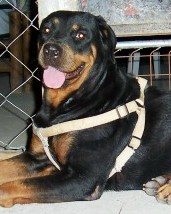Does your dog have leptospirosis? This article might be helpful:
Symptoms
| In acute infections, a fever of 103-104°, shivering, and muscle tenderness are the first signs. |
In acute infections a fever of 103-104°, shivering, and muscle tenderness are the first signs. Then vomiting and rapid dehydration may develop. Severely infected dogs may develop hypothermia and become depressed and die before kidney or liver failure has a chance to develop.
In subacute infections, the animal usually develops a fever, anorexia, vomiting, dehydration, and increased thirst. The dog may be reluctant to move due to muscle or kidney pain. Animals with liver involvement may develop icterus. Dogs that develop kidney or liver involvement may begin to show improvement in organ function after 2 to 3 weeks or they may develop chronic renal failure. Despite the possibility of severe infection and death, the majority of leptospiral infections in dogs are chronic or subclinical. Dogs that become chronically infected may show no outward signs, but may intermittently shed bacteria in the urine for months or years.
Diagnosis
A positive diagnosis can be made through a blood test. A blood sample of the suspected animal is drawn and sent into the laboratory where a microscopic agglutination test is performed. This can test for individual serovars (strains) and the level of antibody (titer) against these strains. Depending on the level of the titer, a positive diagnosis to the specific serovar can be made. Titers may be negative in the first 10 days after initial infection, so many times additional samples must be drawn and tested to get a positive diagnosis. Previous vaccination can give an elevated titer and this must be taken into consideration when interpreting the titers.
Acutely infected or chronically infected dogs will most likely be shedding Leptospira organisms in their urine. It is possible to culture a urine sample and get a positive diagnosis. However, because of intermittent shedding and bacterial contamination this is not always the best way to diagnose the disease.
Treatment
Treatment consists of antibiotics, fluid replacement, and controlling the vomiting and the problems associated with the corresponding kidney or liver infections. Penicillin, or one of its derivatives is the antibiotic of choice for treating the initial infection. After the initial infection is controlled, doxycycline is often used to cure and prevent a potential long-term carrier state. Intravenous or subcutaneous fluids are often given to correct dehydration while the corresponding liver or kidney problems are treated.
Read the rest of the article
HERE.





